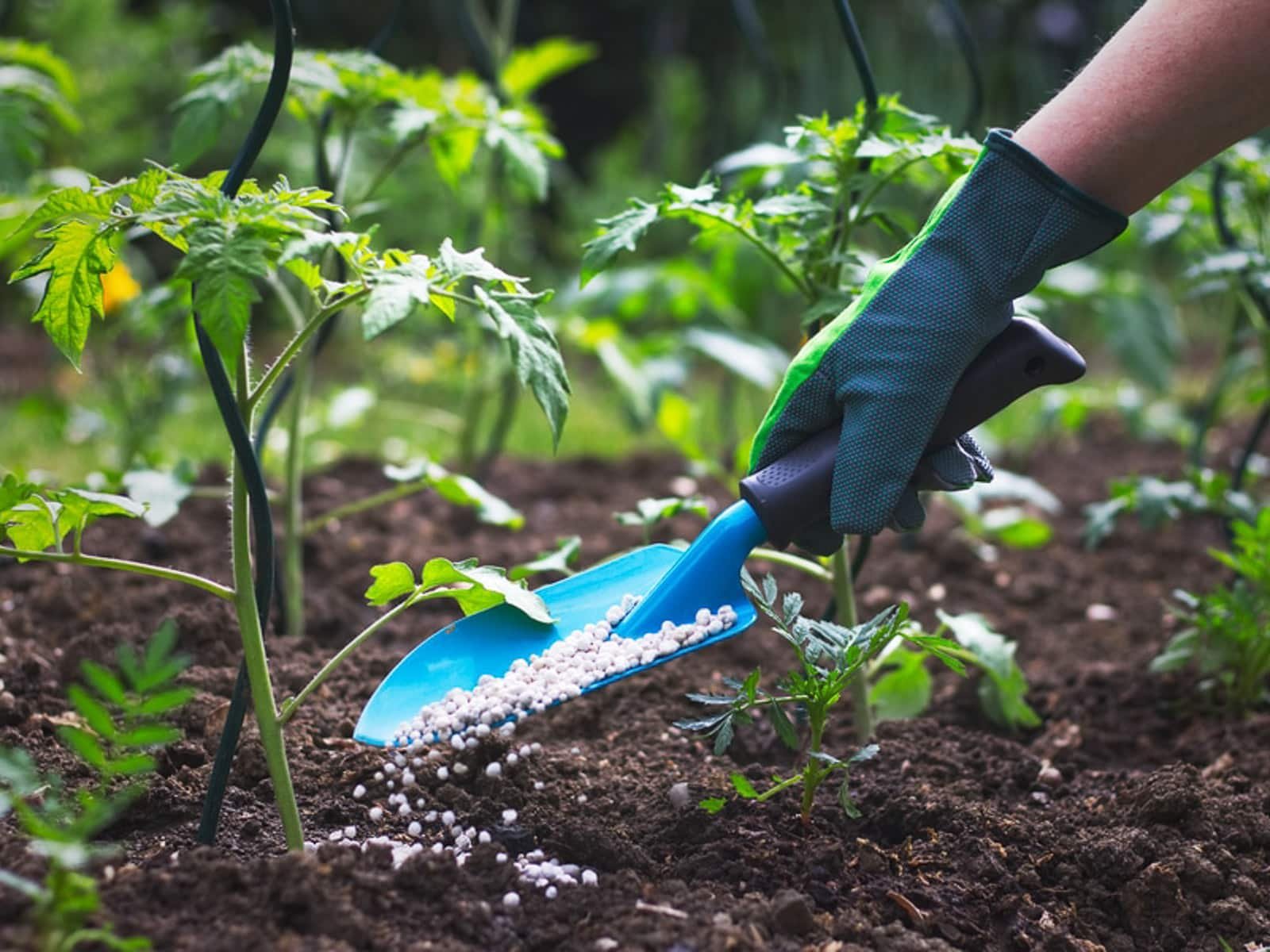For a container garden, be it indoors or outdoors, there are fewer things more impressive than a large planter.
Big containers easily dominate the commercial landscaping world by creating an awe-inspiring focal point or functional room dividers. They also help create a fuller look by elevating the potted plant and adding layers of decor to the space.
Imagine walking into a hotel reception decorated with large planters and luscious trees – who would not be wowed by that?
It’s no wonder that incorporating tall planters and large planters is a top trending design feature, as they effortlessly add a touch of contemporary design to your indoor or outdoor space.
Whether you are looking to use tall planters to frame your shopfront’s doorway or use them inside your restaurant to divide the space, you will need to somehow fill up that large pot.
For this, it is crucial to know how much soil you need, and what kind of filler material is ideal for your needs.
Do You Need To Use Pot Fillers For Large Pots?

The simple answer to this question is – no. You do not strictly need to use filler materials, be it clay balls or pine cones to fill the bottom of a large planter. However, there are some considerations you might want to keep in mind when dealing with larger planters.
There is nothing inherently wrong with treating a big planter in the same way as you would a small planter, by filling the entire pot with potting soil. There are purist gardeners who stand by this view. From their perspective, there can never be too much potting soil for the plant roots to enjoy. Be it a succulent or a large tree, they believe that more space allows for more root growth and hence encourages plant growth.
From the pragmatic and practical point of view, pot fillers and proper drainage play a crucial role. First of all, you save money by not filling the whole planter with potting soil. Potting soil, especially high-quality potting soil can add up quickly in cost! Most plants do not need that much soil.
Secondly, you can adjust the weight of your filled large planter depending on whether you use heavy fillers or light materials. Considering factors like what size of drainage holes in large planters can help prevent issues. This will be helpful to tailor to the needs of your garden.
Third, when it comes to tall planters, the issue of proper drainage could arise. Choosing appropriate drainage hole sizes is essential to prevent waterlogging. Soil compresses under its own weight and can become very compact. This affects the soil’s ability to allow excess water to leave the containers through the drainage holes.
Waterlogged soil creates ripe conditions for root rot, which can be detrimental to the health of the plant. Therefore, knowing what to put in the bottom of large planters for proper drainage and aeration is important.
Therefore, while it is not a requirement to use fillers in large planters, it is definitely a good idea!
Top read: Planting In Tall Pots 101: How To Plant, Fill, And Arrange
Lightweight Pot Fillers

Carefully consider the mobility needs of your container garden. If you are using large planters as temporary space dividers, if you need to move the planters indoors when winter comes around, or if you simply desire to change the layout of your garden every so often, you have to keep big containers as lightweight and easy to move as possible.
Clay, ceramic, and porcelain pots are already heavy materials, as are concrete or stone containers. Even plastic pots and fiberglass containers, considered to be the lightest pots on the market, will become cumbersome to move with the added weight of the potting soil.
If you have come to the conclusion that you will need to keep things light and easier to move, read on to learn about the best pot fillers to fill the bottom of a large planter.
Compostable Materials
- Coconut fiber
- Paper cups
- Wood chips
- Sphagnum moss
- Recycled cardboard pieces
- Pinecones
Non-Biodegradable Materials
- Styrofoam peanuts/ packing peanuts
- Crushed soda cans
- Foam blocks
- Plastic milk jugs
- Plastic bottles/ plastic containers
- Bubble wrap
- Empty potting soil bag
- Empty plastic
Heavy Pot Fillers

There might also be times when having heavy containers are beneficial to your garden or landscaping needs.
If you are planting trees or larger plants in tall planters, chances are you will need a heavier base. A heavy, durable planter will be necessary to withstand the weight of the plant, without the fear of it toppling over. It will need to be more secure and stable than other plants.
Related article: Best plants for large pots
There are other good reasons to have heavy, immobile containers in your commercial or residential space. If you are using the planters as a bulwark or barrier, weighted containers are the way to go. This could be the case if you position them as a property fence or as a Parking area divider. You might also need a planter to be especially sturdy if it is in a high foot traffic area, like a lobby or a kitchen. If you are concerned about theft, a good heavy planter is a great deterrent.
Here are some great heavy packing materials to fill the bottom of a large planter:
Compostable Materials
- Broken ceramic
- Wood logs
- Tree branches
Non-Biodegradable Materials
- Large rocks
- Broken pieces of concrete
- Gravel
- Sand
- Glass pebbles
- Empty beer or wine bottles
- Old golf balls
Compostable versus Non-Biodegradable Pot Fillers
We have organized this list of heavy pot fillers and lightweight pot fillers materials according to their compostable ability i.e. natural materials, as well as non-biodegradable items, which for simplicity’s sake, we are taking to mean products that will not break down any time in the near future.
Which should you use to fill your container garden?

There are certain things to consider when deciding between natural organic materials and non-biodegradable ones.
Organic fillers will break down over time, and this can be a good thing for plant growth. As the pine cones or wood logs decompose, they add nutrients to the soil, acting as a natural fertilizer!
However, as the organic filler decomposes, it disintegrates into the potting soil, which can defeat its original purpose. Hence, it will be necessary to add more filler or soil as this happens.
The non-biodegradable solutions like milk jugs, styrofoam blocks, and bits of plastic pots will not decompose in your lifetime, they will continue to fill the bottom of your large planter for a long time to come. Using decorative planter filler, such as these non-biodegradable options, can also be an environmentally friendly way to repurpose old items that might otherwise be thrown into landfills. However, do note that plastic bottles and jugs may collect water sitting in the pot, which can house and introduce bacteria to the plant.
Be particularly mindful of the filler material if you are growing an edible garden – planting vegetables or fruit for consumption. In this case, bacteria growth could be a prime concern. Even compostable materials like newspapers or paper cups may leech ink. In this case, it’s better to use pure potting soil.
Overall, you have to take into account what you are planting before deciding on what is the most suitable filler weight and material for your garden.
Steps To Get Your Large Planter Ready For Planting
1. Select your large planter
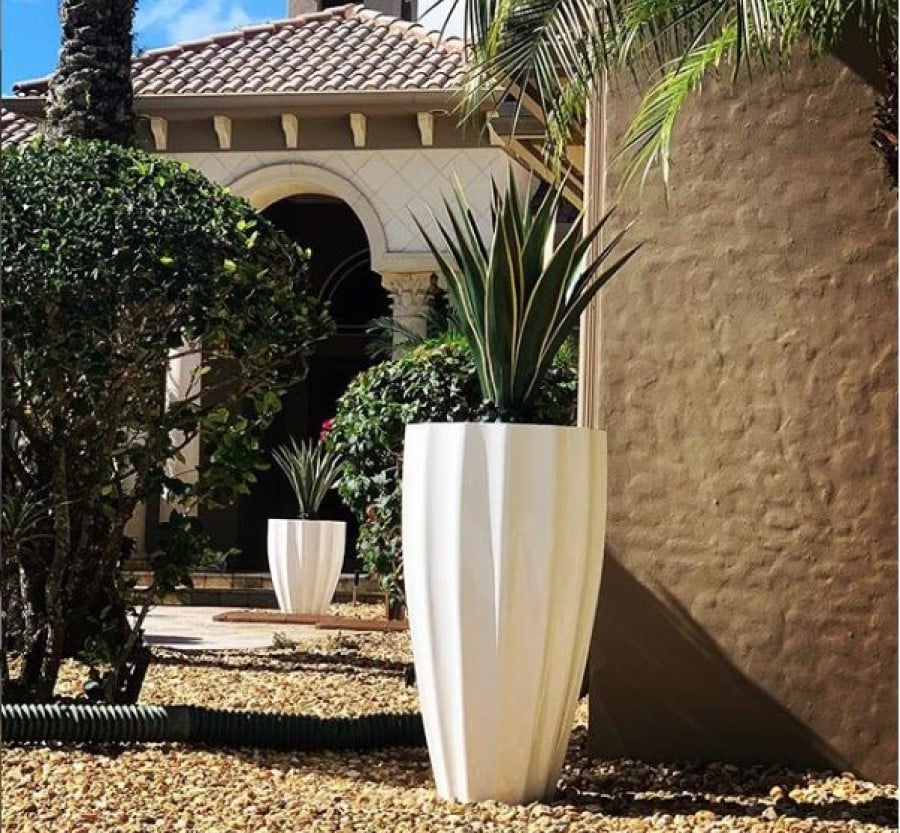
Choose the best material for your plant to keep it happy and healthy. As mentioned, landscape professionals have found fiberglass to be the optimal choice.
If you are reusing a pot, you may wish to clean the exterior by washing it down with hot water and some gentle soap.
2. Make sure there is at least one drainage hole

Adequate drainage is essential for the plant’s roots, including ensuring the appropriate size of drainage holes in large planters. Ensure you have at least one drainage hole at the bottom of your large pot. A few holes are ideal. Though we don’t recommend this for indoor planters. You can always opt to install your own drainage holes with a masonry drill bit; however, this is an unnecessary hassle.
We are happy to help to drill holes at the bottom of any large planter you select to ensure good drainage and protect against root rot.
Top tip: Make sure the drainage holes are not plugged by the filler items – this prevents efficient water flow.
3. Add the pot filler

Next, depending on how much space you need, put enough filler into the bottom of a large planter. Use either lightweight pot fillers or heavy pot fillers as is suitable for your needs. Make sure you do not overfill the large container, leaving enough room for root depth. You can research the needs of the plant online or check in with your landscaper.
If you are going for light fillers like styrofoam blocks, you may want to place a heavy brick or tile first at the bottom to stabilize the container. It is a good idea to cap water bottles or plastic jugs to avoid water collecting in them. If you are going for packing peanuts, it’s good practice to pack them in a sack or a plastic bag. This ensures a neater removal should you need to empty the container in the future.
If heavy items are what you choose to fill the bottom of your tall planter, then be sure to start filling it once it has been installed in the exact spot you wish your planter to stay permanently.
Double-check that whatever filler you choose is healthy for your plants, especially if they are meant to be eaten.
4. Place landscape fabric over the filler

The fabric is there to prevent the soil from sliding down to the bottom of your container as there will be gaps between your fillers. To stop potting soil from filtering down and filling the gaps, place a layer of landscaping fabric between your filler and potting soil layers.
Landscape fabric can be purchased from your local garden center. Otherwise, a piece of plastic screen, mesh, cheesecloth, or even newspaper is suitable too. Make sure water can flow through the fabric easily for good drainage.
5. Put in your potting soil

Now, you are ready to fill up the large planter with potting soil. Fill the planter to about two inches below the rim to reduce water overflow.
It is generally advisable to avoid using garden soil or soil from the ground, as these often are filled with seeds of weeds, and may not have sufficient nutrients or fertilizer to support the plant’s health.
Potting soil is essential, particularly for indoor plants, as it is soil that is lightweight and well balanced with organic material, peat, and perlite, and helps water drain out.
6. Place the plant

Congratulations! You are now ready to place the plant in its home. Plant it firmly in the center of the large container. Press the potting medium firmly around the base of the plant and make sure that there are no roots showing. Water the plant thoroughly until water begins to drain out of the bottom.
Read on for our 101 guide on planting and arranging tall planters.
How Much Filler To Use For Your Large Container?
As all astute landscapers are aware, root growth is crucial for a healthy plant. Ensuring an optimal environment for the roots to grow is easy with a large planter.
Big is generally better in this instance. Flowering and fruiting is diminished if there is too small a space. A larger planter also reduces the need to repot the plant every year.
So, how much filler should you be using?
Herbs and Vegetables
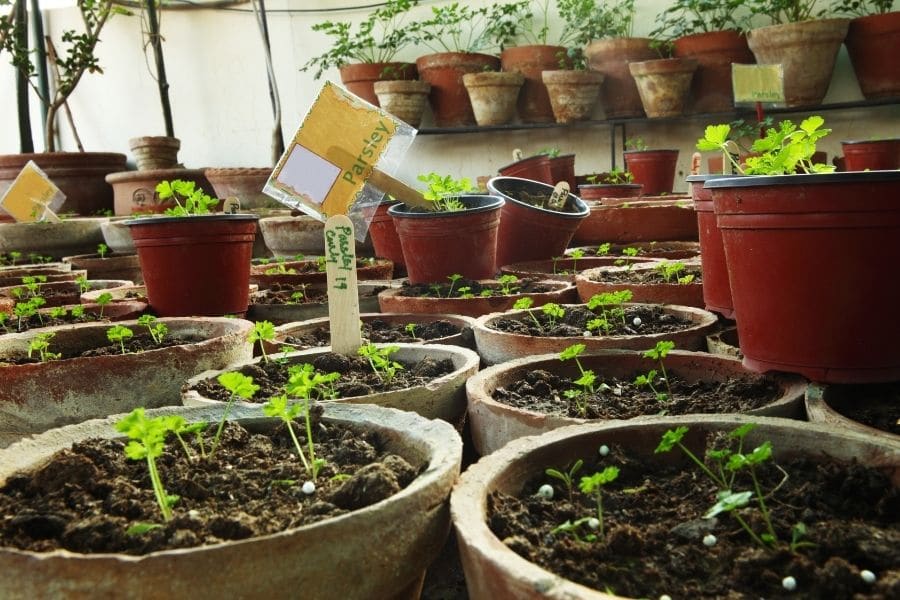
Most herbs can grow well with a depth of 6 to 8 inches. Whereas vegetables like Beans, Beets, Cucumbers, Garlic, Peppers, Lettuce, Kale, and Spinach need a minimum depth of around 8 to 10 inches.
Large rectangular planters are a great way to grow a vegetable garden as a project for your office or to add a unique design element to your restaurant. The raised height of the planter makes it easier to manage and is an eye-catching look!
Annuals

Annuals are plants that only live for one growing season, they germinate, flower, and reproduce all during that time. They tend to have a longer blooming period and are known for their season-long array of showy, enticing colors. Great examples of these are Forget-Me-Nots, Marigolds, and Petunias.
Most annual flowers have shallow root systems, so 4 to 8 inches of depth is ample.
Perennials
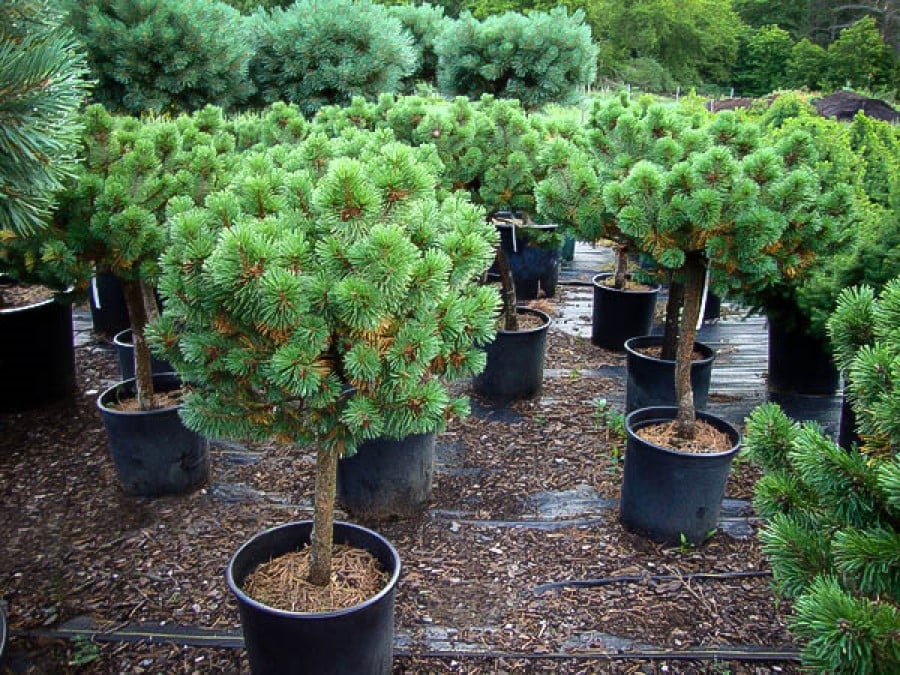
The term perennials literally translates into ‘through the years’, it is a plant that lives for at least two years, and flowers year after year. They are often thought of as the backbone of the garden, providing a consistent landscape. They usually only bloom for one season each year.
Some examples of perennials include
- Black-eyed Susan
- Begonia, Holly
- Maple Tree
- Pine Tree
- and many herbs, fruits, and vegetables.Perennials, like bulbs, require a planting depth of 8 inches, while trees need a depth that is at least twice that of their root ball. When in doubt, speak to your landscape professional about the exact needs of your perennial plant.
Every container landscape requires a mix of the above plants for a good show all year round.
Flowers in particular look great and thrive in round planters, and we have many other great shapes and styles of landscaping planters to create an attractive environment for your business or home.
Check out our guide on the best shape and size of pots for plants.
Why Is Fiberglass The Best Material For Big Planters?

Selecting the material for your container is always important, but it is even more critical when it’s for a large pot. Especially when it comes to large planters, you will need to have a container that is sturdy, dependable, reliable, and will last a long time.
You will have to choose between terracotta, metal, plastic, wood, and more. Within the commercial gardening community, fiberglass is generally considered the top choice.
Landscape professionals like fiberglass materials as they are lightweight, durable, and weather-resistant. Unlike clay or terracotta which are seasonal planters, fiberglass can stay out all year round and look pristine.
Our large fiberglass pots also come in a wide variety of colors, shapes, and textures, and can be customized to suit your project needs and complement your business branding style.
Read on for everything you need to know about extra-large planters.
Fill it Up
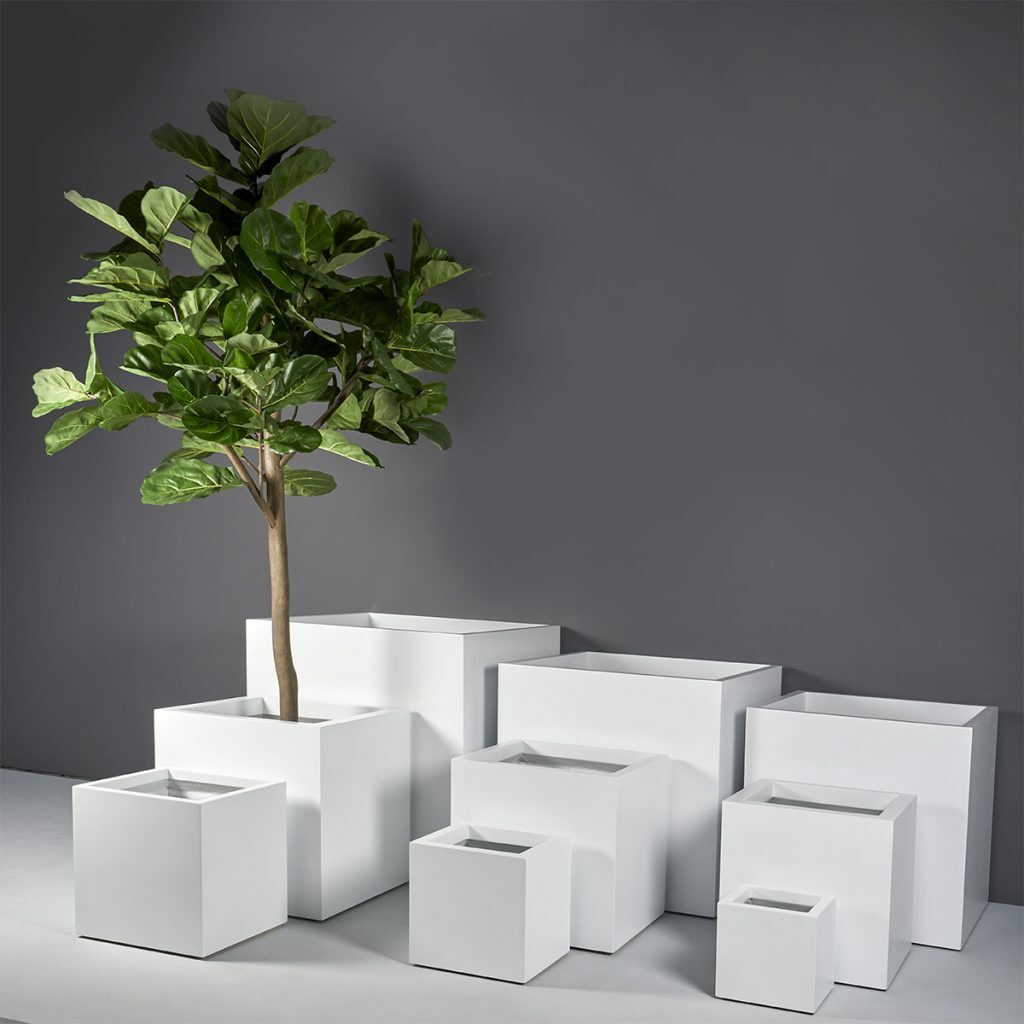
For tall and large planters, fiberglass continues to be the top choice material for landscapers, as they can be produced in huge sizes while still remaining lightweight.
Versatile, sturdy, and long-lasting, the best part about our products is that our fiberglass planters are basically zero-maintenance. They do well in restaurants, outdoor decks, campuses, and car parks, with unmatched professional design exterior and flexible style.
The quality of the planter is especially important when it comes to larger planters, as the stability and sturdiness of the container must not be compromised.
To underscore our commitment to quality and performance, all our planters come with an industry-leading warranty.
With that in mind, whether you are using a large planter to grow an indoor tree or a herb garden project, we hope this guide will show you the best method to fill the container to suit your needs and to ensure that your plants grow up happy and healthy.
Contact us today to begin developing your landscaping solution. Our consultants are ready to help your planter dreams come true!
